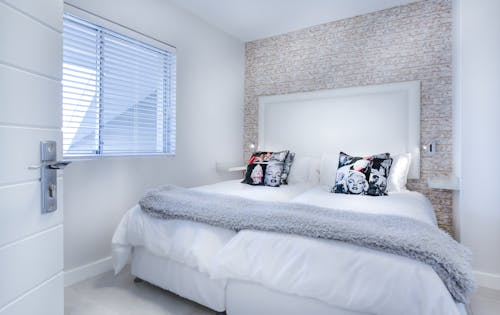By George House/06,Nov,2025
Many homeowners overlook how much difference the average bedroom door size makes in comfort and function. The right door is not only a door that makes a room complete, but also describes movement, privacy, and proportion.
Whether you’re upgrading your space or building a new home, understanding standard bedroom door dimensions helps you avoid awkward fits and noisy gaps. Getting the bedroom door height and width right also improves accessibility and energy efficiency.
It is about frame alignment, thickness, and so on. This guide explores all the measurements, variations, and fitting tips you’ll need to make a smart decision about your next typical interior door size.
Understanding the Average Bedroom Door Size

(Source)
The rest of the process is easier with an understanding of standard dimensions. Once you know the standard bedroom door dimensions, you can start thinking about thickness, frame alignment, and height variations.
Most modern homes rely on a typical interior door size between 28 and 36 inches in width. A bedroom door height and width of 80 by 32 inches balances space efficiency and comfort. The proportions are also adhered to by builders to ease the process of replacement and renovations.
Smaller bedrooms can be equipped with narrower doors, but they must have a reasonable frame-to-wall proportion. The trick is to maintain the alignment and have a sufficient clearance of hinges and locks without jeopardizing style or security.
Elements That Influence The Size Of Doors

(Source)
All the details, such as hinges, trims, etc., influence the performance of your door. Understanding bedroom door frame dimensions helps prevent warping, rattling, or awkward gaps. The following sections subdivide the particular factors that affect the fit and functionality of doors within the architecture of a room and the effect that those details have on the durability.
Frame/Trim
A door frame must match the standard door size for a bedroom to function smoothly. Frames usually add an extra two inches to the bedroom door height and width, allowing for hinges, latches, and insulation.
Proper framing will guarantee noise minimization and less difficult swinging. Aesthetics are also involved in decorative trims. They are to be perfectly aligned to prevent visual imbalance. Matching trim thickness with wall depth completes the installation and keeps the interior door measurement guide accurate during the fitting process.
Thickness of the Door and Material
The standard door thickness for bedrooms typically measures 1⅜ inches. This measure is strong and is lightweight enough to use on a daily basis. Research conducted by the National Institute of Standards and Technology (NIST) indicates that heavier doors minimize sound transmission by a quarter.
Performance is also dependent on materials. Hollow-core doors are used in bedrooms because they are cheaper, whereas solid-core doors are more insulated. The decision between the two lies in privacy preferences, climate, and budget.
Regardless of material, maintaining the correct typical interior door size ensures the hardware fits securely and prevents sagging. Equal ratios are important to ensure reliability in the long run and a professional finish.
Hardware and Swing Direction
Door hardware placement can influence the average bedroom door size you select. Hinges, handles, and latches demand additional spacing outside the door panel. The clearance of inward-swinging doors should be at least 32 inches to be accessible.
Outward swings can help save space in smaller rooms. The position of locks and knobs also affects where the bedroom door frame dimensions should sit within the wall opening.
Even minor deviations may cause creaks or an inappropriate seal. The installation of good hardware that augments the thickness of the doors makes the operation smoother and more comfortable, and functional.
Installation and Fitting Suggestions

(Source)
Accurate fitting is the difference. Before installation, review the interior door measurement guide for your specific model. Minor errors in measurements may lead to sticking doors or gaps. The next few tips cover step-by-step guidance to align frames, balance the swing, and maintain the common door sizes for homes standard without future readjustments.
Accuracy in Measurement
Accurate measurements determine how well the average bedroom door size fits into your frame. The rough opening should always be measured and should be approximately two inches wider and higher than the door.
According to the U.S. Environmental Protection Agency (EPA) research, it indicates that air leakages through improperly sized doors may add up to 10 percent to the energy costs.
Before ordering, use a level to make the wall plumb straight. Record the standard bedroom door dimensions carefully and double-check before cutting trim or hinges. Accuracy is now a saving of future repairs and a comfortable and noise-free bedroom. A well-fitted door is smooth to the touch whenever it is closed.
Pre-Hung vs. Slab Doors
A standard door size for a bedroom can come as either pre-hung or slab. Pre-hung doors consist of the frame and hinges and are easier to install by an amateur. According to Housing.org, pre-hung doors save 40 percent of time in installation.
Slab doors, however, are the best in terms of replacements or custom frames. The bedroom door height and width must match perfectly to prevent uneven gaps. And regardless, place shims to stabilize the frame and firmly fix it. Consistent bedroom door frame dimensions ensure both styles perform well over the years of opening and closing.
Basic Mistakes to Watch Out for
Many homeowners misjudge the average bedroom door size by forgetting to include frame clearance. Others choose doors that are too thick to fit the available walls. Such errors may result in hinges that are noisy or latches that are off-center.
It is best to follow an interior door measurement guide to confirm every inch before installation. Do not over-tighten screws or trim too close to the hinge. An installed door opens easily and remains silent over the years, thus sparing you unnecessary maintenance or replacement expenses.
These might look like small mistakes on the surface, but they can lead to significant issues down the road. It is important that you get the measurements accurately so that you get the right door size for your bedroom door.
Conclusion
Choosing the right average bedroom door size balances practicality, style, and comfort. From frame depth to finish, each detail affects how a room feels and functions. For installations, upgrades, or replacements, rely on accurate standard bedroom door dimensions and expert craftsmanship.
The bedroom is one of the most important rooms in your home. Therefore, you need to pay special attention to the door size in order to get it right. A small mistake and it can impact the overall look of the bedroom.
George Group ensures precise fittings, high-quality finishes, and dependable results for every project, bringing lasting comfort to every doorway.





